 |
 |
|
 |
First week of LRT attracts more than 90,000 riders |
 |
 |
 |
|
With the Minneapolis skyline in the background, a Hiawatha
light rail train carries passengers on LRT's opening day June 26. Photo
by David Gonzalez
|
If Mn/DOT needs a poster boy for multi-modal travel, Ken Buckeye should apply
for the job.
Since the debut of the Hiawatha light rail transit line in Minneapolis on June
26, Buckeye, Office of Investment Management, has incorporated LRT into his
commuting routine a few days a week.
Apparently others are doing so as well: Metro Transit last week reported that
close to 93,000 riders boarded the trains during the Hiawatha line’s first week
of operation (June 28-July 4)—70 percent more riders than expected. That number
is in addition to the 95,000 people who showed up for free LRT rides on the
opening weekend, June 26-27.
Buckeye’s routine includes biking 15 blocks from his home in south Minneapolis
to the 46th Street station, locking his bike in a corral, hopping the LRT train
to the Metrodome station and then walking one block to catch the 94B express
bus to St. Paul. Previously, he would take a local bus to downtown Minneapolis
to catch the bus to St. Paul or else he would drive.
"The real unexpected benefit of this is that it saves me about 20 minutes
of travel time—even with the extra bike riding," he said.
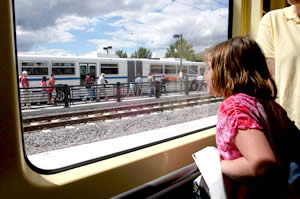 |
|
A young passenger looks at some of the other 95,000
people who took advantage of the free LRT rides offered by Metro Transit
on the Hiawatha line's opening weekend. Photo by David Gonzalez
|
Buckeye pays $1.75 one way for LRT and another 75 cents to use the express
bus. He believes he’ll save a little bit on gas and on the wear-and-tear on
his car, plus he’ll get more exercise and more reading in.
"It’s a trade-off that’s fair," he said.
So far it’s been standing-room-only on his return trip from downtown Minneapolis
to 46th Street, according to Buckeye. One night, he stood elbow-to-elbow with
Hennepin County Commissioner Peter McLaughlin, one of the early proponents of
LRT.
"He had a big smile on his face," Buckeye said.
By Chris Joyce
|
back

|
 |
Floating ‘parade’ celebrates balance of transportation, recreation, environment
along Mississippi |
 |
 |
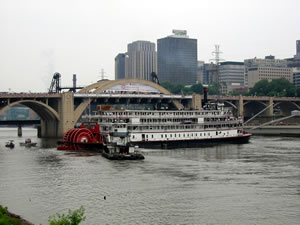 |
|
The Delta Queen steam-driven paddlewheel
boat prepares to dock at the Port of St. Paul with assistance from the
tugboat Itasca. Photo by Donna Lindberg
|
It was a celebration like no other—at least none since 1854.
That’s when the first Grand Excursion—a fleet of riverboats carrying a 1,200-member
entourage of community leaders—traveled up the Mississippi River from Rock Island,
Illinois to celebrate the rail-water connection to the upper Midwest.
The 2004 Grand Excursion ended in St. Paul, as it did in 1854. This time, however,
more people were there to greet riverboat passengers than 150 years ago, when
the flotilla arrived a day early and caught city leaders by surprise. This year,
on July 3, tens of thousands of people stood in the rain to welcome 10 paddlewheel
boats, an authentic steam locomotive train and a bike tour into the Port of
St. Paul.
The journey began June 25 in the Quad Cities of Illinois and Iowa. In Minnesota,
flotilla boats carrying cruise or day excursion passengers stopped overnight
or for a few hours in Winona, Wabasha, Lake City, Red Wing and Hastings. Each
city celebrated the event as well as the community improvement projects that
they completed or began during the last 10 years of Grand Excursion planning.
Lt. Gov./Transportation Commissioner Carol Molnau attended a flotilla welcome
and a ground breaking for the National Eagle Center along the waterfront in
Wabasha, which will be the future home for eagle observation, conservation and
education.
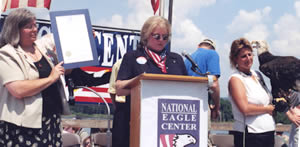 |
Lt. Gov. Carol Molnau reads a proclamation from the governor dedicating the National Eagle Center in Wabasha. From left are National Eagle Center Director Mary Beth Garrigan, Lt. Gov. Molnau and an Eagle Center volunteer holding Harriet, one of three eagles in attendance at the ceremony. Photo by Brian Jergenson |
"Grand Excursion celebrated the importance of balancing transportation,
recreation and the environment along the river," said Molnau. "Projects
like the Eagle Center are examples of how Minnesota communities are revitalizing
their riverfronts and making our state a better place to work, live and play."
Mn/DOT employees in District 6 and Metro District provided traffic and maintenance
assistance during the event. Rest areas were fully staffed and ready to greet
visitors. Changeable message signs notified motorists and bikers of detours,
road closures and event routes. Permits were issued for bridge banners and signs
were added along the Highway 61 Great River Road—the official scenic byway of
the Grand Excursion. Pavement was improved along bike routes and special radios
were provided to the Department of Public Safety Command Center during the event.
"Metro and District 6 did an outstanding job of helping provide a good
travel experience for people attending Grand Excursion," said Carol Zoff,
Office of Technical Support and logistics liaison with Grand Excursion 2004,
Inc.
Grand Excursion information is available on the Web at www.grandexcursion.com.
By Donna Lindberg
|
back

|
 |
Quick, well-coordinated response to tank car derailment draws praise from railroad
official |
 |
 |
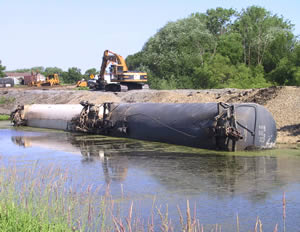 |
|
The derailment of the Canadian Pacific Railway freight
train on Hwy 55 near Glenwood on June 30 tested the skills of Mn/DOT crews
from the Alexandria sub-area and from the Department of Public Safety
and other agencies. No one was injured in the derailment. Photo by
Bill Hanson
|
The derailment of 11 railroad tank cars carrying anhydrous ammonia and other
chemicals along Hwy 55 near Glenwood demonstrated the effectiveness of a quick,
coordinated response by the Department of Public Safety, Mn/DOT and other agencies.
The incident occurred June 30.
The derailment of the Canadian Pacific Railway freight train was the bad news.
Emergency management officials said the good news was that there was virtually
no leakage of the compressed gas into the atmosphere or ground water. If there
had been, the response by public agencies and the railroad would have held environmental
damage to a minimum.
No one was injured in the derailment, but 13 area residents were forced to
leave their homes because of potential danger.
Dean Olson, maintenance superintendent at Morris, said crews from the Alexandria
sub-area responded immediately following the incident to establish a detour
route.
"Our guys were out there setting up barricades and flagging people that
first night," he said. "On the morning of July 1, we were able to
get the detour fully marked with signs made by the Morris sign shop."
The detour route carried Hwy 55 traffic until railroad recovery workers righted
the tank cars and ensured that they were secure.
Olson said the response was well-coordinated by Mn/DOT with DPS, the state
Department of Agriculture, area fire departments and law enforcement agencies.
He said, for example, while Mn/DOT workers flagged and erected signs on the
detour, members of the mounted Pope County Sheriff’s Posse controlled traffic
at several intersections along the detour route and DPS officials tested for
the presence of chemicals from the derailed tank cars.
Phil Marbut, a Canadian Pacific emergency response official, said the well-coordinated
response helped limit damage and assure area residents they were not in danger.
"Great cooperation by state and local authorities was critical to prevent
environmental damage and to convince residents that the way we were going to
proceed was safe and that we would get the job done quickly so they could return
to their homes," he said.
By Craig Wilkins
|
back

|
 |
Bridge-breaking ceremony marks start of ‘Unweave the Weave’ project |
 |
 |
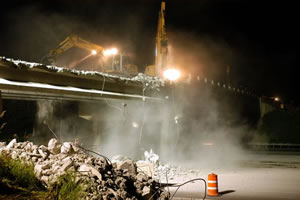 |
|
Night crews work July 9 to take down the Edgerton Street
Bridge over I-694 in Vadnais Heights. Photo by David Gonzalez
|
One barrier to the I-694/I-35E "Unweave the Weave" project disappeared
when workers demolished the Edgerton Street Bridge over I-694 in Vadnais Heights
on July 9-10. The work was completed 30 hours early, much to the pleasure of
Sunday motorists.
After elected officials, community leaders and Mn/DOT staff held a ceremonial
"bridge-breaking," the Lunda demolition crews moved in with their
excavators and other equipment to tear it down.
Removing the bridge is the first step involved in rebuilding the interchanges
in northern Ramsey County that requires motorists to change lanes or "weave"
frequently. The project is one of the first bond-accelerated projects to use
funds appropriated by the Legislature to speed up Mn/DOT’s highway construction
program.
Need for the rebuilding stems from the interchanges being connected by one
mile of common highway with three lanes in each direction. Since its construction
in the early 1970s, increasing traffic and other factors have resulted in excessive
weaving movements and congestion.
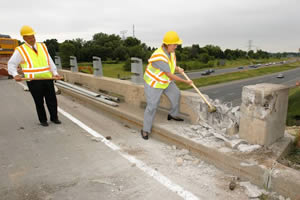 |
| Metro District engineer
Pat Hughes and Sen. Mady Reiter (R-Shoreview) take some ceremonial swings
of sledgehammers to begin the demolition of the Edgerton Street Bridge.
Photo by David Gonzalez |
To correct the problems, the Metro District will add lanes to 3.2 miles of
I-35E and 2.8 miles to I-694 and reconstruct the common section to increase
capacity and reduce the need for drivers to make lane changes.
Construction in the I-694 and I-35E interchange area will begin in 2005. The
project was originally planned to begin in 2008.
To view the status of other bond-accelerated projects, go to http://www.dot.state.mn.us/financing/#projects.
|
back

|
 |
Innovative Construction Initiative joins Construction office |
 |
 |
 |
|
Gary Thompson has been appointed the new state construction
engineer. He also directs the new Office of Construction and Innovative
Contracting. Photo by David Gonzalez
|
The Innovative Construction Initiative officially joined the Office of Construction
to form the new Office of Construction and Innovative Contracting on July 14.
The office will continue to be a part of the Engineering Services Division.
ICI was established in 2003 to explore new methods to deliver construction
projects faster, standardize Mn/DOT’s design-build program requirements and
strengthen Mn/DOT’s relationships with its partners and stakeholders. The Office
of Construction is responsible for the traditional design-bid-build contracts
and processes. It made Minnesota one of the first states to use electronic bidding,
which allows bids to be completed and sent electronically.
"Integrating these units will help incorporate the technical knowledge
and experience gained from ICI into Mn/DOT’s everyday business practices,"
said Dick Stehr, Engineering Services Division director. "This merger also
allows us to take another step forward in streamlining the organization and
provide a better transportation system for Minnesota."
Gary Thompson has been appointed state construction engineer and will serve
as the director of the new office. He’s been working closely with Mike Marttila,
Office of Construction director, to combine the units’ functions. Marttila,
who has been with Mn/DOT for 39 years, retires July 14.
"Mike Marttila has done an excellent job as the director for the Office
of Construction," said Stehr. "We hate to see him go—he will be greatly
missed by all who had the chance to work with him."
Thompson is a 35-year Mn/DOT veteran. His experience encompasses 19 years in
construction and maintenance where he served as a project engineer in Golden
Valley and as the I-394 resident engineer. He has also worked 16 years in various
traffic positions and has held many management positions including Metro Division
traffic engineer, Metro Division maintenance engineer and director for the Office
of Traffic, Security and Operations.
"Under Gary’s leadership, ICI has led Mn/DOT’s efforts in design-build
construction, bond-accelerated projects and in the creation of FAST (Freeing
Alternatives for Speedy Transportation) lanes, " said Stehr. " I am
confident that he will do exceptionally well as the director of the new office."
Thompson will be located on the first floor of the Transportation Building
and can be reached at 651/215-0445 or via e-mail.
By Daneeka Marshall-Oquendo
What’s innovative contracting?
Innovative contracting includes alternatives to the traditional design-bid-build
method of constructing projects.
As the world continues to evolve, so does the world of transportation.
Congestion continues to grow and demands are even greater from the public.
"Using innovative contracting methods helps accelerate the delivery
of projects and improve the quality of our transportation network,"
said Gary Thompson, director, Office of Construction and Innovative
Contracting.
ICI staff has spent many months visiting with the districts and introducing
new ways to deliver construction projects. Each district committed to
using one or more of the following innovative contracting methods in
a construction project:
"The districts are the real champions here," said Thompson.
"Without their cooperation and willingness to try these new things,
we would not be able to move in the direction the transportation world
wants to take us."
|
|
back

|
 |
Human Resources staff completes study of information technology classes |
 |
 |
Clarification (July 30, 2004): Although
most employees demonstrated that they did 70 percent information
technology-related work and remained in the IT classification,
nearly half of them were reallocated to a lower-level IT position.
The department-wide Information Technology Study is now complete after a six-month-long
review of the information technology specialist classifications for positions
at level three and above.
A human resources panel, with the help of key experts, reviewed 147 ITS positions
to confirm their current classification levels.
Nearly half of the employees demonstrated that their activities were 70 percent
IT-related work and remained in the same classification, while the others moved
into a different classification.
"Those positions that were moved will be considered reallocations effective
July 19," said Rich Peterson, Office of Human Resources director. "However,
each employee will retain their current salary and will be placed on a recall
list making them eligible to be recalled to their previous position should an
opening occur."
Peterson also said that employees would retain their seniority from the previous
classification if they did not move to a different bargaining unit.
"This is phase two of the administration’s reorganization initiative,"
said Kevin Gray, Finance and Administration Division director. "Just as
we did with the manager’s study, we are using this tool in our efforts to make
Mn/DOT work better and that means putting people in the right positions.
"We want to do what is best for the employees without compromising the
goals and objectives of the department," said Gray.
Employees have approximately a month from July 19 to formally appeal the decision
in writing to the Office of Human Resources, but they must include information
not previously presented in order for the decision to be reconsidered.
"We are confident that we provided a fair and thorough review of each
position and placed each one in its proper classification," said Peterson.
"But we want to give employees the opportunity to share any new information."
To evaluate the positions, Human Resource staff reviewed position descriptions,
considered key expert advice and, as necessary, interviewed individual employees.
Division directors made final approval of each classification change.
By Daneeka Marshall-Oquendo
|
back

|
 |
WANTED: Volunteers for Mn/DOT’s State Fair exhibit |
 |
 |
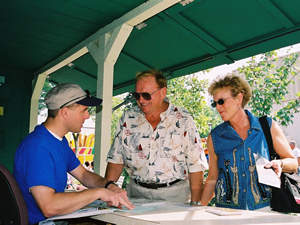 |
|
Todd Kramasz, Regional Transportation Management Center,
was one of Mn/DOT's volunteers at the 2003 Minnesota State Fair. Employees
can sign up, with their supervisors' permission, to work at this year's
booth. Photo by David Gonzalez |
What’s a State Fair volunteer? A champion, an ambassador, a highly qualified
and devoted employee who will help make the Mn/DOT exhibit at the 2004 Minnesota
State Fair a success.
The theme for this year’s Mn/DOT fair exhibit is year-round Work Zone Safety
and 511 Traveler Information Services. The snowplow will again act as the great
orange anchor to the exhibit, and Charlie Brown—in full Mn/DOT safety gear—will
be the exhibit mascot.
As in the past, three volunteers are needed for each of two six-hour shifts
every day of the fair, which runs from Aug. 26 through Sept. 6. Many shifts
are still available, especially in the afternoon and over the Labor Day weekend.
"I encourage the participation of Mn/DOT employees in the fair booth,
as it is one of our most effective tools to communicate our safety messages
and connect with citizens," said Bob McFarlin, assistant to the commissioner
for Transportation Policy and Public Affairs.
"Mn/DOT’s presence at the State Fair allows us to increase public awareness
of Mn/DOT’s value and reassures citizens that we continue to provide a quality
level of service."
All volunteers will receive a T-shirt and an admission ticket. Of course, there’s
the added advantage of working close to a French fry stand and the dairy building…mmmm,
malts! However, volunteering at the fair is also important work and requires
preparation. Volunteers are expected to attend one of three one-hour training
sessions and follow the rules for good state fair volunteer conduct.
Employees interested in volunteering for the Mn/DOT State Fair exhibit need
approval from their supervisor and fill out a form. To obtain a form, contact
Glenn Payton, State Fair volunteer coordinator, at 651/215-1987 or by e-mail.
The signed form must be returned to Payton at MS 635, by July 23.
"State fair volunteers are valued representatives of Mn/DOT who will help
us reinforce our work zone safety message—Work Zones: Pay Attention or Pay the
Price," McFarlin said.
By Donna Lindberg
|
back

|
 |
New book helps kids understand the bridge-building process |
 |
 |
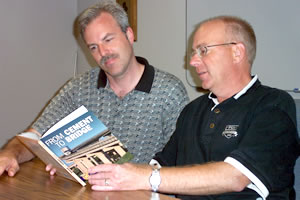 |
|
From left, Mark Spafford, Bridge Construction Section,
and Dan Dorgan, Office of Bridge director, check out the newly published
"Cement to Bridge" book for young readers. Photo by Craig
Wilkins
|
Mark Spafford’s three young sons know their dad works on bridges, but now,
thanks to a book he helped create, they understand his work even better.
Spafford, an engineering specialist with the Bridge Construction Section at
Oakdale, collaborated with a writer to help create "Cement to Bridge,"
a book about bridge-building for children aged 4 to 10.
The plainly written, well-illustrated book takes readers through the stages
of bridge construction, from making concrete to placing beams.
Spafford’s work on the book started when Dan Dorgan, Bridge office director,
received a call for help from Gretchen Bierbaum of Lerner Books in Minneapolis.
Bierbaum was looking for assistance with technical terms. She received that
plus the photos taken by Spafford and his co-workers as well as their expertise
in the sphere of bridge construction.
Once the book was in draft form, Spafford and Bierbaum reviewed it several
times to ensure accuracy and completeness. The book was published this spring.
"Cement to Bridge" joins Lerner’s "Start to Finish" series
that includes "Rock
to Road," a book that features photos by Mn/DOT’s David Gonzalez.
Both books are available from the Mn/DOT Library.
Spafford said he has read the book several times with his sons.
"I learned a lot about editing and producing a book and they learned what
it takes to build a bridge," he said. "It’s a good book for kids to
learn from."
By Craig Wilkins
|
back

|
 |
|
 |



